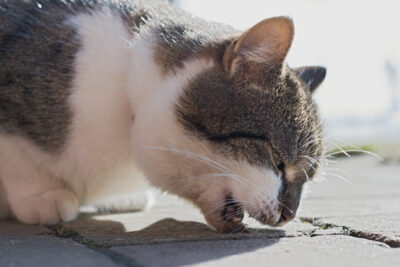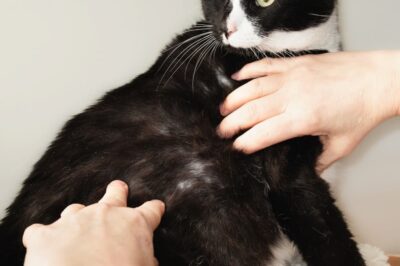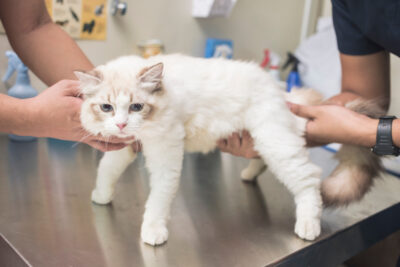Meningitis in Cats: Signs, Causes, Treatments

Overview
Meningitis in cats is a serious disease that requires aggressive treatment. Fortunately, meningitis in cats is rare.
Initially, the signs of cerebral meningitis in cats are vague—tiredness, loss of appetite, hiding. Almost every cat illness has these same symptoms. This is why it is important for a veterinarian to evaluate your cat. The sooner your veterinarian can diagnose and treat meningitis, the more likely your cat will have a good outcome.
What Is Feline Meningitis?
Meningitis is inflammation of the layer of protective tissue that covers the brain and spinal cord. That tissue is called the meninges. The suffix -itis means inflammation. Often if there is swelling of the meninges, there is also swelling of the brain it protects. Inflammation of the brain tissue is called encephalitis. Together, inflammation of both the brain and meninges is called meningoencephalitis. If the spinal cord tissue is also involved, it’s called meningoencephalomyelitis.
Many of the causes of feline meningitis are infectious. Therefore, cats who spend time outside are at the highest risk for meningitis. Unvaccinated cats who live outdoors are at the highest risk for contagious meningitis.
There are no breed or sex differences in risk, although there does appear to be a genetic predisposition for the autoimmune (non-infectious) form of the disease.
Meningitis is not directly transmissible between cats. However, some of the infectious causes of meningitis may be transmissible. This means cats who share an environment are also likely to share exposures to organisms that cause meningitis.
What Causes Meningitis in Cats?

There are many infectious causes of meningitis in cats, including bacteria, viruses, fungi, parasites, tick-borne diseases, and single-celled organisms called protozoa. Overall, feline infectious peritonitis (FIP) is the most common cause of meningitis in cats.
In cats, bacterial meningitis is more rare than the other infectious origins. Other causes of feline meningitis include auto-immune disease and certain types of chemicals or toxins.
Sometimes, despite diagnostic testing, veterinarians cannot determine a cause for feline meningitis. These cases are idiopathic, meaning the condition has an unknown cause.
Types of Meningitis in Cats
There are several types of meningitis in cats, including:
Auto-immune: An overreaction of the immune system causes inflammation of the meninges.
Bacterial: Bacterial meningitis is more common in livestock than pets.
Fungal (e.g., cryptococcus): Fungal meningitis can be localized to the brain and spinal cord or can be a result of disseminated infection, meaning the fungus is found all over the body.
Viral: This is the most common cause of meningitis in cats. FIP and Feline Leukemia Virus (FeLV) are both known to reach the brain and cause meningitis. Viral meningitis carries a grave prognosis—it is generally a fatal disease.
Protozoal (e.g., toxoplasmosis): Protozoa are single-celled organisms. They can arrive in the meninges through the nose, ears, bloodstream, or open wounds.
Parasitic: Parasites (for example roundworms, bot flies, etc.) can find their way into the meninges and cause localized inflammation and/or infection.
Idiopathic: When no cause of meningitis can be found, it is called idiopathic. Unfortunately, idiopathic meningitis has a poor prognosis.
What Are Signs of Meningitis in Cats?

The symptoms of meningitis in cats vary widely from minimal to severe, from slow onset to rapid progression, and from specifically neurologic to non-specific whole body signs.
The most common signs of meningitis are fever, neck pain, muscle spasms, and severe pain that is difficult to localize. Other signs include lethargy, blindness, abnormal movements, paralysis, behavior changes, seizures, and coma.
Cats with meningitis also often have encephalitis (and vice versa), which means cats are likely to have encephalitis symptoms. Signs of encephalitis include a head tilt, walking in circles, and loss of balance.
The signs of meningitis depend on the location of the swelling, whether around the brain, cerebellum, spinal cord, or multiple locations. The symptoms do not differ between the causes of meningitis, which is part of what makes diagnosis difficult.
To recap, here is a list of signs of meningitis in cats:
- Fever
- Pain
- Muscle spasm
- Blindness
- Inability to walk or poor balance
- Abnormal gait
- Lethargy
- Seizures
- Abnormal body movements
- Head bobbing and other abnormal head movements
- Head tilt
- Agitation or changes in behavior
- Weakness
- Coma
Diagnosing Feline Meningitis
The diagnosis of feline meningitis starts with a thorough history and physical exam. Bloodwork and X-rays are useful to rule out the presence of other more common illnesses and injuries. The specific tests required to diagnose meningitis are evaluation of the cerebrospinal fluid (CSF, the fluid that goes around and through the brain) and an MRI to confirm the presence of inflammation. A veterinarian may order these tests when bloodwork and X-rays of the body appear to be normal but a cat has persistent or progressive neurologic signs.
Cat Meningitis Treatment Options

The treatment for meningitis in cats depends on the cause. Results of a cat’s CSF analysis will determine whether they need antibiotics, antivirals, antifungals, or antiparasitics.
The success of treatment depends on the cause and how quickly treatment is initiated. It can vary widely. Some cats return to normal with treatment, while other cats get no relief from treatment or may even worsen.
Auto-immune and idiopathic forms of meningitis are treated with steroid medication. Protozoal meningitis can sometimes be effectively treated with antibiotics. Parasitic meningitis is typically treated with anthelmintic medications as well as antibiotics.
All forms of feline meningitis require supportive care: fluids, feeding assistance, and pain control to give the specific medication time to take effect. Sometimes these cats can be treated at home, but most cats with meningitis require at least some amount of hospitalization until their symptoms can be managed.
Prognosis for Cats with Meningitis
Immune-mediated, tick-borne, and protozoal forms of meningitis have the best likelihood of a positive outcome, although overall the prognosis for any type of meningitis is still guarded. The other forms of meningitis, such as bacterial, fungal, and viral, carry a poor prognosis. Getting your cat into the vet at the first sign of a problem can go a long way to helping them get better.
Cost to Treat Meningitis in Cats

The cost to diagnose and treat cat meningitis varies but it is a significant financial investment due to the cost of diagnostic testing and hospitalization. An MRI and CSF analysis can cost $3,000-$6,000. Hospitalization is in the range of $1,000-$3,000 per day. Some cats may only require a few days while other cats may require weeks in the hospital in order to adequately manage their pain.
How to Prevent Meningitis in Cats
While there is nothing a pet parent can do to prevent meningitis specifically, there are steps they can take to help prevent some of the causes of meningitis. Keeping your cat indoors and up-to-date on vaccines — including the FeLV vaccine — significantly reduces the risk of meningitis. It’s also important to keeping your cat on year-round parasite preventatives.









